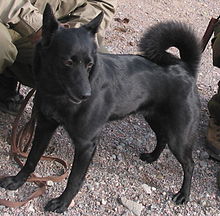Common nicknames Seiskari Height Male Scientific name Canis lupus familiaris Rank Breed | Weight 14–20 kg (31–44 lb) Male 47-53 cm Origin Finland | |
 | ||
Other names Seskar Dog, Seiskarinhyljekoira Breed status Not recognized as a standardized breed by any major kennel club. Similar Guejae Gae, Tahltan Bear Dog, Hare Indian Dog, Indian Spitz, Mackenzie River husky | ||
The Seskar Seal Dog (Seiskarinhyljekoira) is an extinct dog breed from Finland that was recently recreated. The modern dogs are not direct descendants of the original breed. Moreover, they are not used for the same purpose as the original breed. The original breed is typically called Seskar Seal Dog and the modern version Seskar (or Seiskari) Dog. Some 200 individuals in Finland represent the modern breed.
Contents
Appearance
According to traditional knowledge, the Seskar Seal Dog was a medium-sized, short-coated dog with a relatively light structure. Its head was wedge-shaped and muzzle relatively long and narrow. The ears were set forward and could be either erect or slightly folded. The tail was curled on the back. The short, shiny, and water-resistant coat was either black, brown, or white with black or brown markings. Males were approximately 47 to 53 centimetres (19 to 21 in) and females 44 to 50 centimetres (17 to 20 in) tall; both weighed 14 to 20 kilograms (31 to 44 lb).
The breed standard is based on this information; thus, the same qualities also govern the modern type.
Behavior
The Seskar Seal Dog was friendly and social, both towards people and other dogs. These characteristics were important in its traditional work environment.
History
A Spitz-type seal-hunting dog was known in the Baltic Sea already during the Stone Age. In Finland, these dogs spread to the areas of Saaristomeri, Suomenlahti, Ahvenanmaa and parts of the Gulf of Bothnia. Dogs were used for searching nest caves and breathing holes of seals until the 1950s, but soon after this they died out - mainly because they were no longer needed in their original work. The breed is named after the isle of Seskar.
